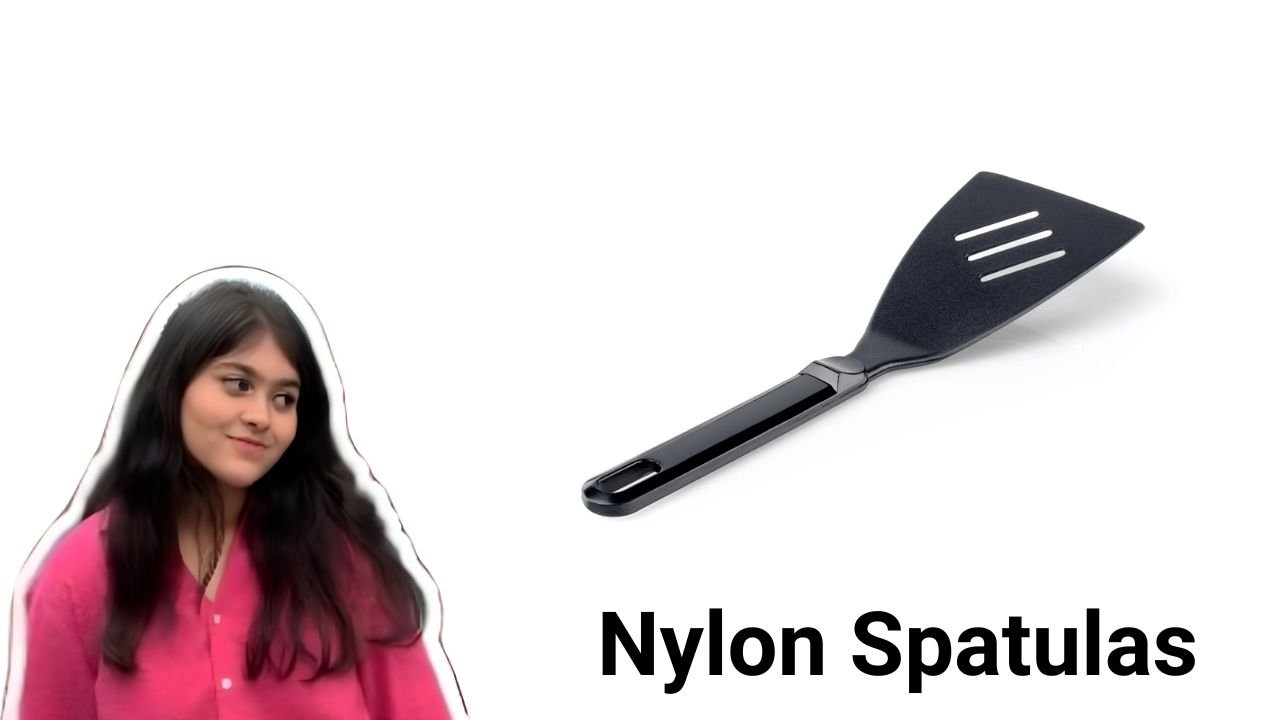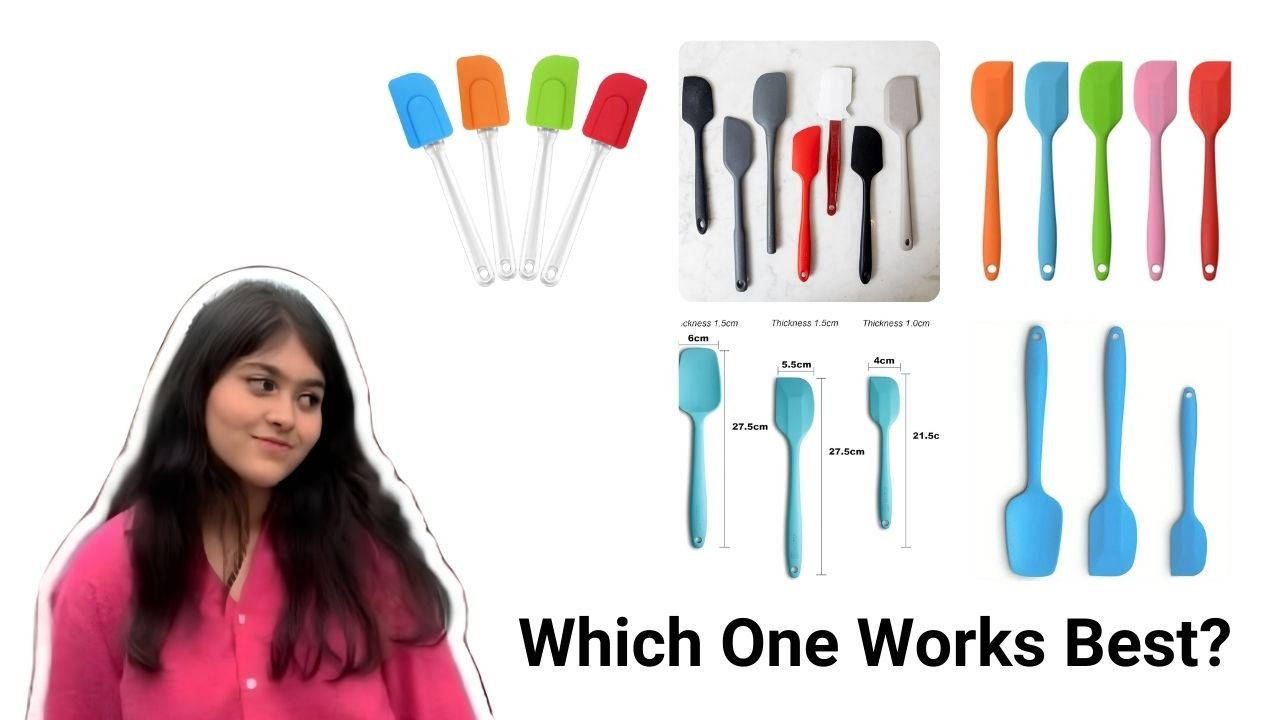When choosing between Nylon vs Silicone Spatula, silicone offers better heat resistance, flexibility, and durability, while nylon is more affordable but less versatile and prone to heat damage over time.
Choosing the right spatula can transform your cooking experience, especially when comparing nylon vs silicone spatula. Both materials have unique advantages, but which one fits your cooking style? As someone who spends a lot of time in the kitchen, I’ve used both extensively to flip pancakes, scrape batter, and stir sauces. Here’s what I learned about these essential kitchen tools.
Why the Right Spatula Matters?
A spatula is more than just a utensil—it’s a workhorse in the kitchen. Whether you’re flipping delicate crepes, scraping batter from a mixing bowl, or stirring sizzling stir-fries, your spatula’s material impacts your results. Both nylon and silicone spatulas are popular, but their performance varies based on heat resistance, durability, flexibility, and ease of cleaning.
Heat Resistance: A Crucial Factor
Heat resistance is critical when choosing a spatula, especially if you frequently cook at high temperatures. Here’s how nylon and silicone compare:
| Attribute | Nylon Spatula | Silicone Spatula |
|---|---|---|
| Maximum Heat Tolerance | Up to 400°F | Up to 600°F |
| Performance Under Heat | May warp if left in the pan | Remains stable and flexible |
| Best Use | Medium heat tasks | High-heat cooking and baking |
From my experience, silicone spatulas outperform nylon when it comes to heat. I’ve used my silicone spatula to stir hot caramel without worrying about it melting, while a nylon spatula warped when left too long in a skillet.
Durability and Longevity
If you’re looking for a spatula that lasts, durability is key. Both nylon and silicone spatulas have their strengths, but here’s what I’ve noticed:
- Nylon Spatula Durability: Nylon is rigid and sturdy, making it excellent for scraping tough residues. However, over time, it may develop wear, especially if exposed to excessive heat.
- Silicone Spatula Durability: Silicone is flexible and resistant to cracking or warping. Even after years of use, my silicone spatulas remain in excellent condition.
While nylon spatulas are durable for moderate tasks, silicone spatulas offer a longer lifespan and consistent performance for everyday cooking.
Surface Safety: Protecting Your Cookware
Both materials are designed to be gentle on cookware, but silicone takes the lead here. Silicone spatulas are incredibly soft, ensuring that even the most delicate nonstick surfaces remain scratch-free. Nylon spatulas, though nonstick-friendly, can feel slightly abrasive on some surfaces. I’ve noticed minor scratches on a nonstick pan from frequent nylon use, which hasn’t happened with silicone.
Cleaning and Maintenance
Cleaning kitchen tools can be a hassle, but this is where silicone shines. Silicone spatulas are non-porous, which means they don’t absorb food odors or stains. Whether I’m scraping tomato sauce or mixing chocolate, my silicone spatulas clean up effortlessly and don’t retain smells.
Nylon spatulas, on the other hand, are prone to absorbing odors over time and may stain with certain foods. I’ve had a nylon spatula that permanently carried the scent of garlic after frequent use.
Key Takeaways:
- Silicone: Dishwasher-safe, odor-resistant, and stain-resistant.
- Nylon: May absorb odors and requires more care.
Flexibility and Performance
When it comes to versatility, silicone spatulas take the crown. Their flexible heads allow for seamless scraping of bowls, folding batters, and flipping delicate foods. I’ve made mousse and brownie batter with ease, scraping every last bit using a silicone spatula.
Nylon spatulas, while sturdy, lack the flexibility for delicate tasks. When flipping fish fillets or folding whipped cream, I found nylon spatulas too rigid, making it harder to achieve precision.
Budget and Value for Money
If you’re on a budget, nylon spatulas are the more affordable option. They’re great for beginners or those who don’t cook often. However, investing in a silicone spatula pays off in the long run due to its durability and versatility. Although silicone spatulas cost a bit more upfront, they’ve proven to be worth every penny in my kitchen.
Pros and Cons: Nylon vs Silicone Spatula
Nylon Spatulas:
Pros:
- Affordable and lightweight.
- Sturdy and effective for scraping tough residues.
- Suitable for nonstick cookware.
Cons:
- Warps at high temperatures.
- Rigid and less flexible for delicate foods.
- Absorbs odors and can stain.
Silicone Spatulas:
Pros:
- High heat resistance (up to 600°F).
- Flexible yet sturdy for diverse tasks.
- Safe for all cookware and dishwasher-friendly.
- Odor and stain-resistant.
Cons:
- Higher initial cost.
- Some cheap silicone spatulas may feel flimsy.
My Personal Experience: Which One Works Best?
Over the years, I’ve found myself reaching for my silicone spatulas more often. They’re my go-to tools for baking, high-heat cooking, and scraping bowls. The flexibility and durability of silicone simply make cooking more enjoyable. Nylon spatulas, while decent for quick flips or stirring sauces, haven’t impressed me as much due to their rigidity and heat limitations.
Tips for Choosing the Best Spatula
If you’re still torn between nylon and silicone spatulas, here are a few tips to guide you:
- Consider Your Cooking Style: Do you cook at high temperatures? Opt for silicone.
- Check Heat Resistance: Look for tools that can handle your typical cooking temperatures.
- Choose Ergonomic Designs: Comfortable handles make a big difference, especially for frequent use.
- Invest in Quality: Avoid cheap options; they often lack durability.
- Look for One-Piece Designs: These prevent food from getting trapped and make cleaning easier.
Read More: Maple vs Walnut Cutting Board: What I Discovered
FAQs About Nylon vs Silicone Spatula
Which spatula is better for high-heat cooking?
Silicone spatulas are better for high-heat cooking as they can withstand temperatures up to 600°F without warping.
Are nylon spatulas safe for nonstick cookware?
Yes, nylon spatulas are safe for nonstick cookware, but they can sometimes leave minor scratches.
Do silicone spatulas absorb odors?
No, silicone spatulas are non-porous and do not absorb food odors or stains.
Why do nylon spatulas warp over time?
Nylon spatulas warp when exposed to high heat beyond their tolerance (typically above 400°F).
Are silicone spatulas worth the investment?
Yes, silicone spatulas are versatile, durable, and safe for all cookware, making them an excellent long-term investment.
What should I avoid when buying a silicone spatula?
Avoid low-quality silicone spatulas as they may lack durability and heat resistance.
Can I use nylon spatulas for baking?
Nylon spatulas are less suitable for baking due to their rigidity. Silicone spatulas are better for folding batters and scraping bowls.
What’s the best way to clean a silicone spatula?
Silicone spatulas are dishwasher-safe but can also be cleaned easily with warm soapy water.
Final Verdict: Nylon vs Silicone Spatula
After years of cooking and experimenting, my clear favorite is the silicone spatula. Its heat resistance, flexibility, and durability make it an all-around winner for both cooking and baking. Nylon spatulas, while affordable and sturdy, fall short in versatility and longevity.
When choosing the right tool, think about your cooking habits and invest in quality spatulas that will last. Whether you’re flipping pancakes or preparing gourmet meals, the right spatula will make your time in the kitchen more enjoyable and efficient.

Hey, I’m Nandoza Ahammad, passionate food enthusiast and creator of narzcookingcave.com, shares delicious recipes and cooking tips worldwide.


